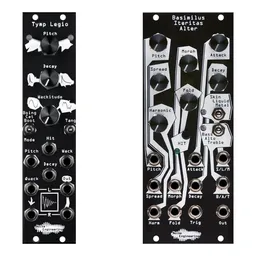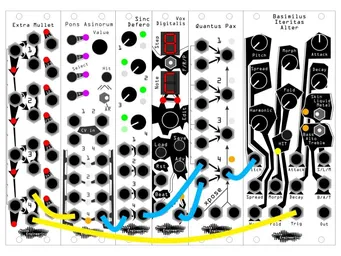We recently released the Tymp Legio, a 6 HP drum voice on the Legio platform. Since its release, we’ve received a number of questions about how it’s different from our ever-popular 10 HP Basimilus Iteritas Alter. In this post, we’ll go over their key differences, similarities, and do some jamming, too. Hopefully by the end of this post you’ll know which one is right for you! (Or, if you’re like me, you’ll want both.)
If you haven’t seen the Tymp Legio yet, you can check out the review we did of that here. And if you’ve never heard of the Basimilus Iteritas Alter, you can check that out here.

What similarities do the BIA and Tymp Legio have?
Let’s start with how these two modules are the same. Both the Tymp Legio and the BIA are complete voices (they are sound sources that do not require a VCA or envelope) designed for percussion. They’re both based around the concepts of additive and FM synthesis, and they both cover a huge range of synthetic percussion sounds from hats to snares to kicks to toms and a whole lot more. They both track 1v/oct, too, so you can easily pitch sequence them to use them for melodic duties. If you just need a module that will cover some synthetic drums in your system, you can’t go wrong with either – it all comes down to workflow.
Is Tymp Legio a miniature BIA?
The most common question we’ve received is whether or not the Tymp Legio is just a shrunken-down BIA. The answer is that, while Tymp takes inspiration from the BIA, it is an entirely new instrument with a completely new synthesis engine. Tymp has a very different form factor, and we embraced the limitations of a much smaller interface as a way to try out some more immediate ideas. We wanted it to be a great partner for BIA, rather than supplant it.
You’ll notice differences in the timbre of the two as well: the Tymp is stereo, and makes use of that in some of its sounds to create some interesting wide effects. The BIA can get crunchier with its wavefolding and wavemorphing, but you’ll hear a slightly different flavor of distortion on some of Tymp’s modes if that’s what you’re going for. Tymp also has a slightly longer decay time on some of its kick settings, and it also has some specialized settings that excel at metallic hat sounds.
The BIA can break out of the realm of percussion more easily: both modules track 1v/8va, and the Tymp can play a melody or bassline quite well – but the BIA’s larger footprint lends itself to more parameters and thus, increased tweakability. That makes it my go-to for basslines and melodies.
The bottom line is that the two are different, and for good reason: Tymp was designed to complement the BIA. I have them both patched next to each other in my case. Throw in a little CV, and they make a fantastic drum kit.
Instant gratification vs. flexibility in drum sound design
One of the biggest differences between Tymp and BIA is their workflows. Tymp is more immediate: we wanted Tymp to sound great right out of the box. Select a class of sound with the left switch, pick a variation of that sound with the right, and tweak it with the Decay and Wackitude knobs. If you’re not a fan of dialing in the exact sound you want, Tymp makes it easy to jump between timbres with just a few tweaks. Tymp’s pitch, Decay, and Wackitude parameters can be CV controlled, too. Due to its size, its switches don’t have CV inputs, so it’s all about the hands-on jamming.
Of course, the counterpoint to this is flexibility: with only a few tone controls on Tymp, you can’t dial in the same number of sound variations as you can on the BIA. The BIA is known for its gigantic range: with 7 tone controls, three synthesis algorithms, and CV over every single parameter, BIA can do quite a lot with a bit of tweaking or external modulation. This does mean it takes a bit more adjusting to go between sounds, though we don’t hear people suggesting it is an excessively difficult task.
It’s worth mentioning that, in terms of absolute flexibility, the Tymp has an interesting leg up as it is part of our Legio platform. This means its firmware can be changed at will to be an oscillator, a compressor, or more alternate firmwares still in the works.
Quack! Ducking external signals to kicks and snares with Tymp Legio
One thing the Tymp can do that is quite a lot of fun is duck external audio to its kicks, snares, and toms. The stereo Quack input makes it easy to create pumping effects that are commonly used in many genres of dance music. This also means that multiple Tymps can be chained together with no mixer required: for instance, run a kick Tymp into a snare Tymp into a hat Tymp and you’ll get a whole drum kit at the final output! BIA has no ducking input, so if ducking is key for your workflow, Tymp may be your module.
Percussion for all modular rigs
We get it, HP is real estate and in some cases, real estate is limited! Maybe you have a small performance skiff, maybe you’re traveling, maybe you just want to fit your percussion into a smaller space. If that sounds like you, Tymp may be for you. While we love to use Tymp and BIA together, it was important to us to design Tymp so that it had a variety of the percussion we wanted at our fingertips. We are excited about how much percussive goodness we smashed into 6 HP. If you have a little more space, BIA with its 10 HP footprint may be for you.
If you collect or have a lot of space…well we can’t tell you what to do, but if you’re as obsessed with percussion as Kris is, you’ll want them both. Maybe more than one of each. We are considering an intervention for her.
You can’t go wrong either way
We’re quite proud of both of these percussion voices, and if you’re deciding between the two, you’re sure to have fun either way. We hope this post has made the choice a bit easier, but if you’re still on the fence, you can learn more about each on their respective pages, or check out our social media for videos of each! Still have questions? We’re always here to help, just drop us a line.





